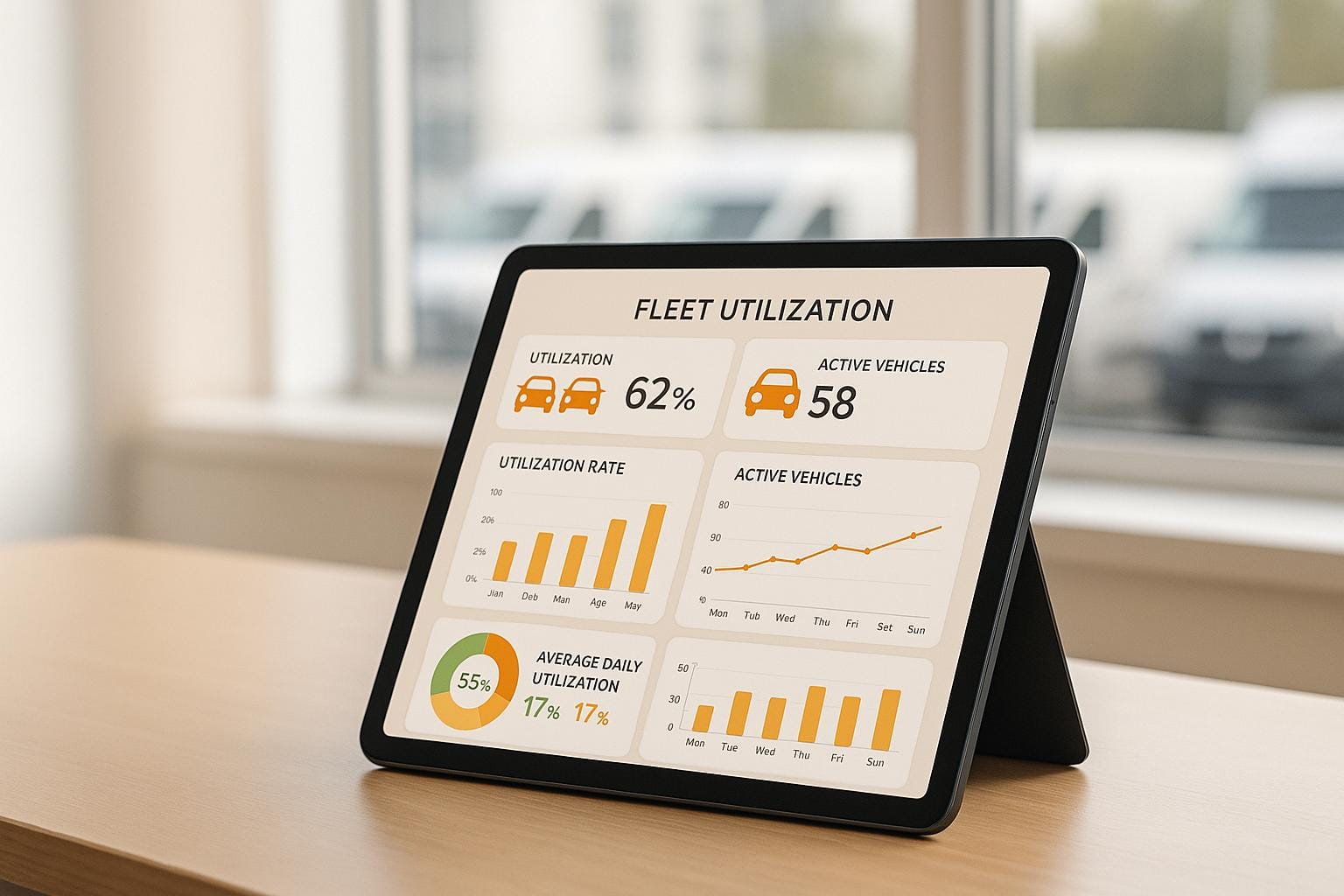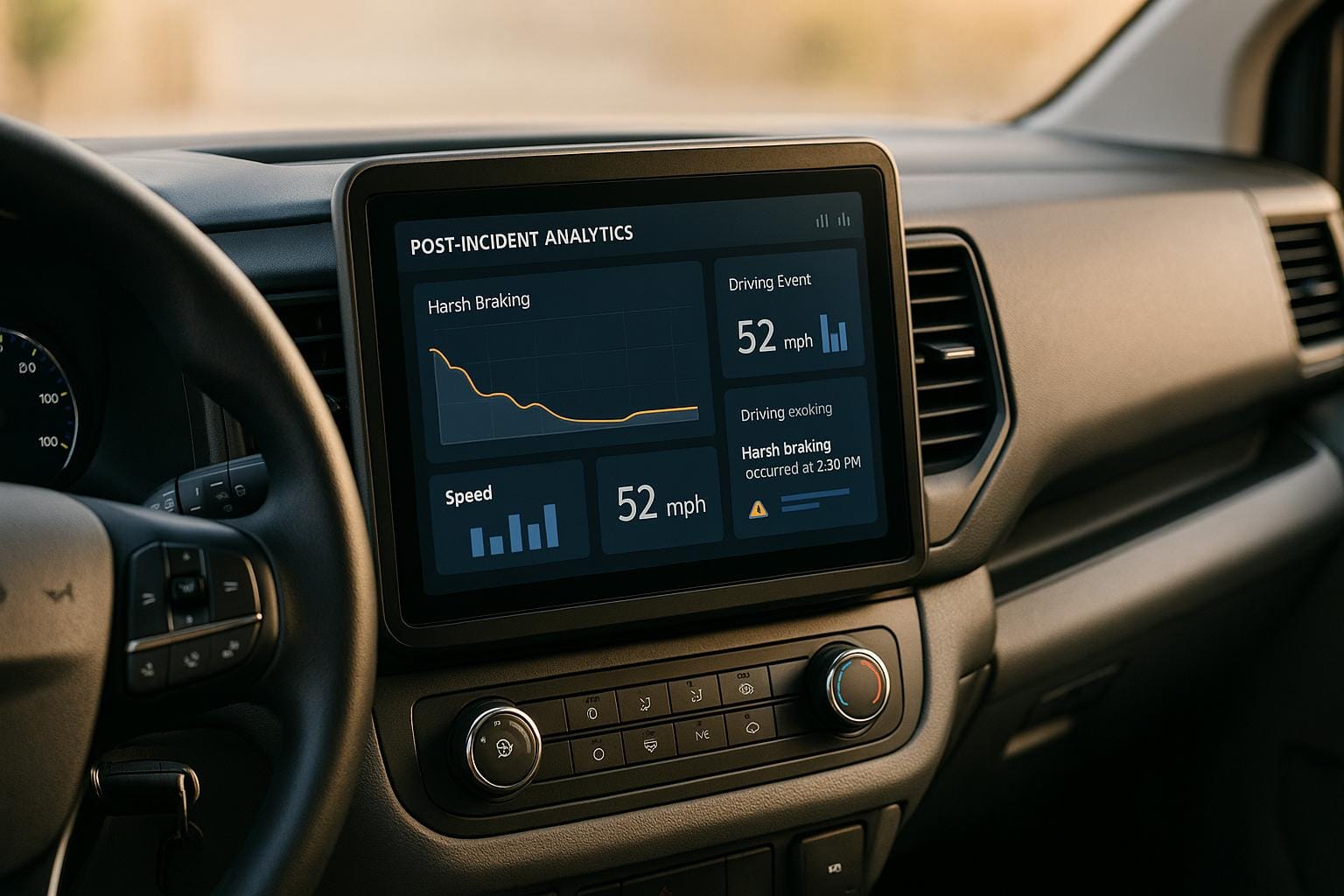Telematics can reduce driver risk by up to 75%, cut accident rates by a third, and save fleets thousands annually. Here's how it works:
- Real-Time Driver Monitoring: Tracks speeding, harsh braking, and more, helping managers identify risky behaviours instantly.
- Instant Feedback & Coaching: Alerts drivers immediately to correct unsafe actions, reducing crashes by up to 72%.
- Accident Detection & Risk Analysis: Uses AI to detect incidents and prevent escalation, lowering accident costs and claims.
- Regulatory Compliance: Automates reporting and ensures adherence to UK driving laws, saving time and avoiding penalties.
- Vehicle Security: Prevents theft with GPS tracking, geofencing, and remote immobilisation, achieving a 91% recovery rate.
Quick Comparison Table:
| Telematics Feature | Key Benefit | Impact on Fleet Safety |
|---|---|---|
| Real-Time Monitoring | Identifies risky drivers immediately | Up to 75% reduction in accidents |
| Instant Feedback & Coaching | Corrects behaviours on the spot | 72% fewer crashes |
| Accident Detection & Analysis | Prevents incidents before they occur | Lower claims and repair costs |
| Regulatory Compliance | Automates legal adherence | Saves time and avoids fines |
| Vehicle Security | Prevents theft and aids recovery | 91% recovery rate for stolen vehicles |
Telematics transforms fleet safety by moving from reactive to proactive risk management. With tools like AI-powered dashcams and real-time alerts, it ensures safer roads, fewer accidents, and cost savings for fleets.
1. Real-Time Driver Behaviour Monitoring
Driver Behaviour Tracking and Analysis
Keeping tabs on driver behaviour in real time gives fleet managers a clear picture of driving patterns, helping them respond more effectively. With the help of modern telematics systems, data is continuously gathered from GPS, accelerometers, and onboard sensors. This technology tracks key metrics such as speeding, harsh braking, rapid acceleration, sharp cornering, and excessive idling.
The Geotab Team sums it up perfectly:
"Driver behaviour monitoring is the continuous process of collecting and analysing telematics and sensor data to assess how drivers operate their vehicles."
The collected data includes measurable details like acceleration trends, braking force, cornering angles, and speed fluctuations. Fleet managers can use this information to pinpoint high-risk drivers and introduce tailored coaching programmes. Driver scoring systems take it a step further by assigning numerical scores based on behaviours such as speeding, harsh braking, and adherence to routes.
This real-time data lays the groundwork for swift corrections.
Real-Time Feedback and Corrective Measures
One of the biggest advantages of real-time monitoring is the ability to act immediately when risky behaviours are flagged. Unlike older approaches that rely on reviewing incidents after they happen, today’s telematics systems send instant alerts for behaviours like excessive speeding or harsh braking.
Studies reveal that 40% of drivers modify their habits after receiving their first safety alert through telematics. Considering that human error accounts for 90% of crashes, addressing these behaviours early is vital .
Jerry Hughes, National Procurement Manager at TXM Plant Hire, shares their strategy:
"Anyone going a mile over the speed limit is breaking the law, so we are serious about looking at speeding. But we correlate it to driving time, too - was it an instance of overtaking or were they speeding consistently? The absolute key to this is data, making sure we have reliable data from our vehicle tracking system."
By identifying patterns like excessive idling or unnecessarily long routes, fleet managers can also optimise routes and schedules, cutting down on inefficiencies.
Incident Detection and Proactive Risk Management
Beyond immediate feedback, real-time alerts play a crucial role in preventing incidents before they escalate. These systems, often powered by AI, are capable of detecting unusual driving behaviours and sending instant warnings. This proactive approach is essential, as 29% of collisions occur within one minute of reaching top speed, and 71% happen within the first 10 minutes.
By addressing unsafe habits early, managers can implement timely coaching and training to reduce risks and prevent costly incidents. For example, real-time alerts for harsh driving help drivers adjust their behaviour on the spot, ensuring compliance with safety standards.
One success story comes from Day & Nite, a commercial refrigeration and HVAC services company. By using IntelliShift’s AI-powered dash cameras, they tracked driver behaviour and reduced rear-end collisions by 75% in under six months.
Lytx highlights the importance of these instant notifications:
"Instant alerts provide crucial information when it matters most, warning of potential risks so techs and managers can take proactive measures to prevent accidents and mitigate hazards."
With the help of real-time data, fleet managers can design focused training programmes and integrate coaching into broader safety initiatives, ensuring both drivers and fleets operate more safely and efficiently .
2. Instant Feedback and Driver Coaching
Real-Time Feedback and Corrective Measures
Modern telematics has revolutionised how drivers receive feedback, turning real-time monitoring into a tool for safer driving practices. These systems provide immediate alerts for risky behaviours, allowing drivers to correct their actions right away. This is a significant improvement over older methods that relied on delayed feedback.
Peter Mitchell, General Manager at Verizon Connect, explains how this technology functions:
"Telematics plays a crucial role by continuously measuring safety-related driving behaviours, such as speeding and braking while AI-enabled dashcams provide real-time detection of distracted driving, tailgating and road hazards, amongst others. Together, they optimise fleet safety by delivering timely feedback and alerts, helping drivers adjust their behaviour and respond to risks more effectively."
Alerts come in various forms, including audible warnings, visual notifications, and mobile app alerts. Some advanced systems even offer in-cab alerts, ensuring feedback reaches the driver at the most impactful moment.
Studies underline the effectiveness of instant feedback. For instance, vehicles equipped with in-cab feedback systems experienced 25% fewer harsh driving incidents compared to those without immediate alerts. This kind of real-time intervention not only addresses immediate risks but also lays the groundwork for more structured coaching that promotes safer driving habits.
Driver Behaviour Tracking and Analysis
Telematics systems continuously track a variety of driving behaviours, such as speeding, harsh braking, rapid acceleration, sharp cornering, excessive idling, and seat belt usage. This wealth of data provides fleet managers with actionable insights to identify areas where drivers may need additional training.
Jonathan Hewett, Vice-President at Octo Telematics, highlights this benefit:
"Using these insights, businesses can identify where training might be required to improve driving behaviour and, in turn, help lower costs across the fleet."
Real-time scorecards further enhance the coaching process by giving drivers immediate visibility into their performance, enabling them to make adjustments while still on the road.
A compelling example comes from Ferreira Coastal Construction. Brandon Pensick, Senior Vice President, shared their success story:
"When we first got Tenna, our D and F scores were around 30%. Within three months, they fell into single digits."
This kind of data-driven coaching can lead to measurable improvements in both safety and operational efficiency, ultimately benefiting the entire fleet.
Incident Detection and Proactive Risk Management
Beyond tracking behaviours, modern telematics also detects safety violations in real time and facilitates prompt coaching interventions.
JJX Logistics offers a practical example. Their AI-powered cameras identify specific safety violations, and the footage is immediately reviewed by the operations team. Digital coaching alerts are then sent to drivers before their next shift.
The benefits of such systems are undeniable. Green Tomato Cars, for instance, saw a dramatic reduction in accident costs after implementing their GreenRoad telematics system. Sophie Jacobsen, Head of Service Delivery, noted:
"The telematics has had a massive impact on our accident costs."
Their accident costs dropped from £3,200 per active driver annually to £2,300, saving approximately £250,000 across the fleet.
Fleet managers can also use telematics data to introduce driver league tables, encouraging healthy competition. Enserve Group implemented this strategy in 2025, and Fleet Manager Paul Brown observed:
"Without doing anything else, the peer pressure between grown blokes was doing more to drive the accident stats down than we could have done."
This initiative led to a 25% reduction in accidents at the depot that adopted the league table system.
The shift from reactive to proactive fleet management through instant feedback and coaching is transformative. By addressing risks in real time and fostering ongoing improvement, telematics not only prevents accidents but also helps drivers consistently perform better.
3. Accident Detection and Risk Analysis
Incident Detection and Proactive Risk Management
Modern telematics systems, equipped with accelerometers and GPS sensors, can now detect and assess crashes in real-time. But they don’t just stop at recording incidents - they actively identify risks before they escalate into accidents.
The financial impact of accidents can be staggering, with a single incident potentially costing over £59,000.
Philip van der Wilt, Vice-President for Europe, the Middle East and Africa at Samsara, highlights how telematics has evolved:
"With in-cab alerts and AI-enabled dashcams, it now intervenes in real-time to address issues such as distracted driving or driver fatigue. By detecting risks as they happen and delivering immediate feedback – such as alerts or warnings – telematics actively prevents dangerous behaviours from escalating into incidents and that makes the roads safer for everyone."
Geolocalised alerts further enhance this system by enabling timely reporting. This allows fleet managers to act quickly, dispatching assistance and initiating claims processes without delay.
Beyond immediate alerts, telematics also plays a role in long-term risk reduction through detailed analysis of driver behaviour.
Driver Behaviour Tracking and Analysis
Telematics doesn’t just monitor incidents - it continuously analyses driving patterns to predict and mitigate risks. By studying data trends, fleet managers can identify areas where additional driver training may be required.
Oliver Holt, Geotab EMEA Sales Manager, explains the importance of turning data into actionable strategies:
"The key is turning the data into actionable insights. For example, identifying trends like frequent hard braking can indicate a need for driver training. By employing data to provide proactive coaching, fleets can create safer driving habits and reduce incidents. The data must serve as a guidepost for ongoing improvement."
AI-driven analysis takes this a step further by forecasting accidents based on driving patterns and external conditions. This is particularly significant given that 70% of fleet managers report experiencing incidents linked to distracted driving.
The benefits of behaviour tracking are clear. In the UK, two studies found a 20% reduction in collisions after implementing telematics systems. Additionally, an insurer managing multiple fleets observed a marked decrease in both the frequency and severity of claims.
Dashcams add another layer of insight by capturing contextual information, such as the presence of pedestrians, which raw data alone cannot provide.
Real-Time Feedback and Corrective Measures
One of the most impactful advancements in accident prevention is real-time feedback. AI-enabled cameras can detect high-risk situations before they escalate, allowing for immediate corrective actions. This is critical, especially since distracted driving accounts for 80% of incidents.
Sam Footer, Partnership Director at SureCam, describes how these systems guide drivers:
"Organisations can now identify risk-generating events behind the wheel and automatically prompt the driver to change their behaviour with real-time voice instructions. If the driver doesn't correct their behaviour, event alerts with video are then sent back to base to ensure coaching and training is focused and relevant to the drivers."
The results speak for themselves. Fatigue-related incidents dropped by 66% thanks to in-cab warnings, while safety management solutions helped reduce speeding by up to 90% and overall incidents by 70%.
Telematics systems also streamline the accident reporting process through automatic First Notice of Loss (FNOL) capabilities. This eliminates the usual five-day delay between an accident and the initial report, enabling faster repairs and legal resolutions.
In September 2024, State Farm joined USAA in integrating crash detection into their mobile apps. State Farm’s Drive Safe & Save app, launched in Texas and Florida, uses smartphone sensors to detect collisions, provide safety advice, make emergency calls, and simplify claim filing.
Crash detection technology has been shown to reduce claims costs by up to £800 per claim while also eliminating delays in reporting.
This proactive approach to accident detection aligns with telematics' broader mission: reducing risks and enhancing fleet safety.
GRS Fleet Telematics offers advanced tools for accident detection and analysis, equipping fleet managers with the insights they need to respond quickly and cut costs. By shifting from reactive responses to proactive strategies, telematics is helping to protect drivers, streamline operations, and significantly lower expenses.
4. Regulatory Compliance Support
Regulatory Compliance and Reporting
Fleet operators in the UK have to navigate a maze of driving regulations, from working time directives to vehicle safety standards. Telematics systems simplify this process by automating tasks that were once manual. For example, they handle daily route calculations and generate reports automatically, eliminating the need for manual data entry and reducing the risk of errors. These platforms track essential data like driving time, vehicle location, engine hours, and miles driven - all crucial for meeting regulatory standards. By automating these processes, telematics systems not only save time but also create detailed audit trails that are invaluable during inspections. This seamless approach aligns with the risk management strategies discussed earlier, ensuring compliance without added hassle.
Compliance-Focused Driver Monitoring
Driver behaviour is another area where telematics systems shine. They actively monitor actions such as speed, adherence to safety protocols, and harsh driving events. These systems also log start and end times and flag when drivers approach their statutory Hours of Service limits. With fatigue-related accidents being a major concern, this feature is particularly important. By alerting fleet managers when drivers are nearing their maximum permitted hours, telematics systems help prevent violations and promote safer driving practices.
Real-Time Feedback and Corrective Measures
One of the standout features of telematics systems is real-time monitoring. This allows fleet managers to address compliance issues as they arise, rather than reacting after a violation has occurred. Immediate alerts highlight potential breaches, enabling quick corrective action. For instance, these systems can monitor specific needs like temperature control in refrigerated vehicles or blue light usage for emergency services. By ensuring adherence to strict UK regulations, they not only minimise risks but also enhance fleet performance. These compliance tools are seamlessly integrated into the broader telematics framework, further improving safety and operational efficiency.
Since the introduction of GDPR in May 2018, telematics systems have evolved to ensure that data collection complies with privacy laws while still delivering the insights fleet managers need.
GRS Fleet Telematics offers a robust compliance solution through features like automated reporting, real-time monitoring, and in-depth behaviour analysis. This helps UK fleet operators stay on top of regulatory demands while keeping operations running smoothly.
5. Vehicle Security and Theft Prevention
Security Features and Theft Prevention
Telematics technology is transforming vehicle security, making it a powerful tool for preventing theft. In 2023, vehicle thefts cost UK fleets an average of £12,250, with larger fleets (over 100 vehicles) suffering losses of up to £21,000. Alarmingly, 40% of stolen vehicles were never recovered.
Telematics systems provide robust security measures. Real-time GPS tracking ensures continuous monitoring of a vehicle's location, while geofencing creates virtual boundaries. If a vehicle crosses these boundaries, instant alerts are triggered, and the system can even remotely immobilise the vehicle. These features significantly improve recovery rates compared to traditional methods, which only recover 2–8% of stolen vehicles. By contrast, telematics systems boast recovery rates as high as 95%.
Incident Detection and Proactive Risk Management
Modern telematics systems go beyond just tracking - they actively detect and respond to potential threats. For instance, jamming detection alerts fleet managers if criminals attempt to block GSM or GNSS signals. Similarly, towing and unplug detection notify operators of tampering attempts. Some advanced systems can take immediate action, such as disabling the engine starter or locking all doors when interference is detected.
A real-world example highlights the effectiveness of these systems. A Danish dry-cleaning business recovered their stolen van using a Teltonika FMB020 OBD tracker. The tracker revealed the van’s location in a residential area and exposed its use in transporting stolen goods from a local hotel. This led to the vehicle’s recovery and closure of the case.
For added security, dual GPS tracker systems ensure uninterrupted location data, even if one tracker is disabled. These advanced features not only prevent theft but also support operational improvements by identifying risks and optimising vehicle routes. For example, telematics data can highlight high-risk areas, allowing fleet managers to adjust routes and avoid potential dangers. Secure parking zones can also be geofenced, with instant alerts sent if a vehicle leaves these areas.
GRS Fleet Telematics offers a comprehensive solution to these challenges. Their dual-tracker technology achieves a 91% recovery rate for stolen vehicles. The service includes 24/7 recovery support and three security packages: essential tracking at £35, advanced protection with immobilisation at £99, and a software platform priced at £7.99 per vehicle monthly.
| Security Feature | Traditional Methods | Telematics-Based Methods |
|---|---|---|
| Recovery Success Rate | 2–8% | Up to 95% |
| Time to Recovery | Days to Weeks | Within Hours |
| Real-Time Tracking | No | Yes |
| Instant Alerts | No | Yes |
| Remote Immobilisation | No | Yes |
| Law Enforcement Integration | Limited | Comprehensive |
Driver Risk Management Trends & Predictions
Benefits Comparison Table
This table summarises the impact of various telematics methods, showcasing how they reduce risk while differing in complexity and cost. It complements earlier analyses, helping you make informed decisions about fleet safety strategies.
Real-time driver behaviour monitoring forms the backbone of telematics benefits, capturing data like speed, braking habits, and engine diagnostics. It requires basic hardware and software, making it relatively simple to implement. Case studies show it can significantly reduce accidents.
Instant feedback and driver coaching uses this data to encourage immediate behavioural changes. Many fleets report substantial reductions in crashes and claims with this method. Though it involves moderate investment in coaching systems and training, the results are tangible. IntelliShift explains:
"When drivers see that data is being used to support them - not penalise them - they're more open to feedback. As a result, a telematics-powered culture encourages proactive safety improvements rather than reactive rule-enforcement."
Accident detection and risk analysis focuses on preventing incidents before they occur. While it requires advanced analytics, the long-term benefits include fewer insurance claims and improved safety records.
Regulatory compliance support simplifies adherence to legal standards. Modern telematics systems automate this process, offering an easy and cost-efficient solution.
Vehicle security and theft prevention delivers immediate financial protection. For example, GRS Fleet Telematics uses dual-tracker technology to achieve a 91% recovery rate, with services starting from £7.99 per month.
Each of these methods contributes to building a proactive, safety-focused culture within fleets.
| Telematics Method | Risk Reduction Impact | Implementation Complexity | Cost-Effectiveness | Key Benefits |
|---|---|---|---|---|
| Real-Time Behaviour Monitoring | High (up to 75% accident reduction) | Low | High | Lays groundwork for safety systems |
| Instant Feedback & Coaching | Very High (72% crash reduction reported) | Medium | Very High | Drives immediate behaviour change |
| Accident Detection & Analysis | High (30% speeding reduction) | Medium | High | Proactive risk management |
| Regulatory Compliance | Medium | Low | Very High | Reduces administrative workload |
| Vehicle Security & Theft Prevention | Very High (91% recovery rate) | Low | Excellent | Provides immediate financial protection |
The data highlights instant feedback and driver coaching as the most impactful method, with nearly 33% of fleets using telematics extensively for this purpose. However, for those starting out, real-time behaviour monitoring is often the most cost-effective choice, providing the essential data foundation for other methods.
David Antar, founder and president of IPVideo Corp, underscores the comprehensive value of telematics:
"Telematics is the key for organizations to achieve their goal of improving safety for their commercial drivers near and far, playing a crucial role in improving driver safety and reducing the number of vehicle accidents through real-time monitoring."
Fleet managers should weigh their specific risks and budgets when prioritising telematics solutions. Studies show that businesses implementing comprehensive telematics systems report at least 25% fewer claims and a 50% drop in crashes. With options available for every budget, telematics has become an accessible tool for fleets of all sizes.
This comparison underscores how a tailored telematics strategy can significantly improve fleet safety.
Conclusion
Telematics has transformed fleet management from merely addressing problems after they occur to actively reducing risks before they arise. The five strategies discussed - real-time monitoring, instant feedback, accident detection, compliance support, and secure tracking - are key to safer operations and cost efficiency.
At its core, real-time behaviour monitoring gathers crucial data such as speed, braking habits, and overall driving patterns. This becomes even more impactful when paired with instant feedback systems, which allow drivers to correct unsafe behaviours immediately. Modern telematics takes it a step further, addressing issues like distracted driving or fatigue in real-time, preventing risky situations from escalating into serious incidents.
By implementing these tools, fleets not only save money but continuously improve driver performance. With distracted driving contributing to 80% of incidents and insurance claims spiking by 50% without video safety solutions, telematics addresses some of the most pressing challenges in the industry.
Getting started is simpler than it might seem. Fleet managers can use telematics data to create tailored driver coaching programmes, focusing on the specific needs of each driver. Sharing performance insights with teams shifts telematics from a monitoring tool to a collaborative resource, fostering safer driving habits.
Oliver Holt from Geotab highlights the value of actionable data:
"The key is turning the data into actionable insights. For example, identifying trends like frequent hard braking can indicate a need for driver training. By employing data to provide proactive coaching, fleets can create safer driving habits and reduce incidents."
The financial benefits are equally compelling. Fleets can cut fuel consumption by up to 10%, while camera-based systems often pay for themselves within weeks by providing vital evidence in no-fault claims.
The advantages are undeniable: telematics solutions reduce costs, enhance efficiency, improve safety, and ensure regulatory compliance. As risks in commercial vehicle operations continue to grow, adopting these systems is not just a smart business move - it’s a necessary step to protect drivers, assets, and overall operations.
Interested in reducing your fleet's risks? GRS Fleet Telematics offers dual-tracker technology with a 91% recovery rate and comprehensive solutions starting at just £7.99 per month. Get in touch today to see how advanced tracking can safeguard your drivers and vehicles.
FAQs
How does telematics provide real-time feedback to drivers, and how does this help prevent accidents?
Telematics systems provide drivers with instant feedback by tracking actions like speeding, harsh braking, and rapid acceleration. This real-time monitoring gives drivers the chance to adjust their behaviour immediately, promoting safer driving habits.
Research highlights the impact of this approach, showing reductions in risky behaviours - speeding can drop by up to 80%, while harsh braking incidents decrease by as much as 52%. By encouraging smarter decisions on the road, telematics not only helps reduce accidents but also contributes to safer journeys for all.
How do telematics systems help UK fleet operators stay compliant with driving regulations, and what are the benefits?
Telematics systems play a crucial role in helping UK fleet operators stay on the right side of the law by automating key tasks like tracking driver hours, monitoring vehicle inspections, and keeping maintenance records up-to-date. These features make it easier to comply with DVSA regulations while reducing the chances of non-compliance.
On top of that, telematics offers real-time insights into driving habits, such as speeding or harsh braking, so managers can tackle potential issues before they escalate. Features like driver ID fobs, alerts for rule violations, and live tracking of rest periods add an extra layer of safety and compliance.
For fleet operators, this technology doesn’t just reduce legal risks and avoid hefty fines - it also boosts operational efficiency and encourages safer driving behaviours across the team.
How does telematics help prevent vehicle theft, and how effective is it in recovering stolen vehicles?
Telematics systems are a key defence against vehicle theft, offering features like jamming detection, alarm activation, and engine immobilisation. These tools work together to discourage theft by notifying owners of unusual activity and making it much tougher for thieves to succeed.
If a vehicle is stolen, telematics becomes invaluable for recovery. With GPS tracking solutions, recovery rates often exceed 90%, with many vehicles found within just a few hours. This not only protects your fleet but also minimises downtime and related expenses.




